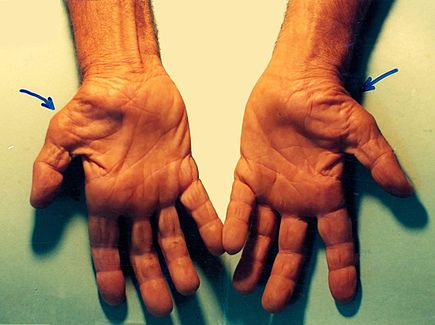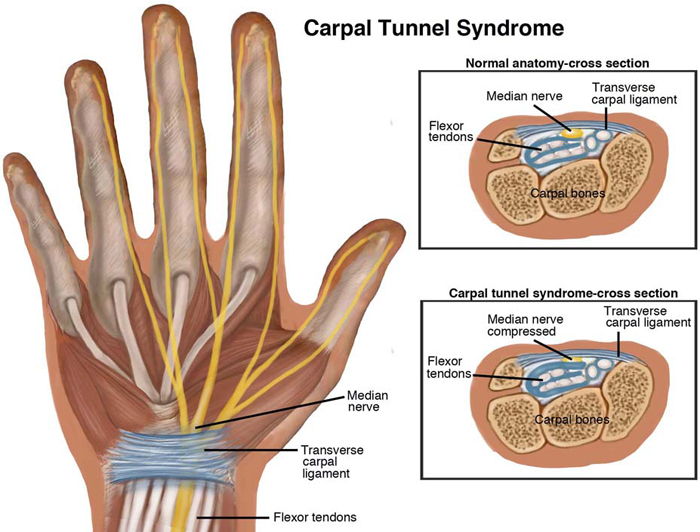nalco group
bone, muscle & joint pain physio
BOOK NOW / WHATSAPP ABOUT YOUR PAIN OR INJURY
- ORCHARD 400 Orchard Road #12-12 Singapore 238875
- TAMPINES 9 Tampines Grande #01-20 Singapore 528735
- SERANGOON 265 Serangoon Central Drive #04-269 Singapore 550265
Home > Blog > Physiotherapy & Hand Therapy > Carpal Tunnel Syndrome Hand Therapy
Carpal Tunnel Syndrome Hand Therapy

Untreated carpal tunnel syndrome, showing how the muscles at the base of the thumb have wasted away (atrophied)
Carpal tunnel syndrome (CTS) is actually a very common condition of the wrist and hand that can affect the use of the whole arm. The main cause of carpal tunnel syndrome is pressure on the nerve at the base of the palm (median nerve).
Because of the demands that people place on their hands and wrists, CTS is a common condition affecting 1 out of 20 Americans (that's a 5% rate). Surgery for this condition is commonly performed on the wrist and hand (called "carpal tunnel release surgery").
Fortunately for most people who develop CTS, hand physical therapy treatment can often provide
- pain relief
- numbness relief
- restore normal use of the hand, wrist, and arm without the need for carpal tunnel release surgery
What is Carpal Tunnel Syndrome?
Every one has a very narrow/tight tunnel in the wrist, and this is called the carpal tunnel (because it's a tunnel at/near the carpal bones of the wrist). There is a number of structures (including the median nerve) that goes into and through this tight tunnel, and what the carpal tunnel does is that it protects the median nerve and the tendons that bend your fingers.
However, due to a variety of causes/injuries, there can be a build-up of pressure on the median nerve that when compressed, will cause
- pain and weakness in your wrist and hand
- numbness or tingling from your thumb to the long half of your index finger
If the pressure is unresolved, over time it will lead to carpal tunnel syndrome.
Extreme wrist positions, as well as a lot of finger use, especially with a lot of force or vibration (such as holding the steering wheel when driving heavy machinery), can all contribute to CTS.
CTS is common in professions such as assembly-line work, particularly meat packing; and jobs requiring the use of hand tools, especially tools that vibrate.
Yes, eventhough excessive mobile phone, keyboard and computer use is often associated with carpal tunnel syndrome, those performing assembly line work are 3 times more likely to develop CTS than those who perform data entry work.
Some leisure activities can also create CTS, such as
- sewing and stitching
- painting
- writing
- sports
such as racquetball and handball and
- playing string instruments such as
the violin and guitar
The following health conditions can also lead to CTS in some individuals:
- Inflammation and swelling of the tendons of the wrist
- Injuries to the wrist (strain, sprain, dislocation, fracture)
- Hormone or metabolic changes (pregnancy, menopause, thyroid imbalance)
- Fluid retention (eg, during pregnancy)
- Diabetes
- Certain medicine use (eg, steroids)
- Degenerative arthritis and rheumatoid arthritis
And yes, direct injuries and traumas like falls and blows can cause CTS too.

Signs and Symptoms of carpal tunnel syndrome
CTS usually starts gradually, with symptoms such as
- burning
- tingling
- "pins and needles"
- numbness in the palm of the hand and fingers
Often the symptoms are more noticeable during the night, and individuals often report being wakened with symptoms. Many people feel the need to "shake / shake out" their hands to try to relieve the uncomfortable CTS symptoms.
As the condition progresses, the symptoms are noticed during the daytime and are noticeable or becomes worse when using their hands with a repetitive/resistance/weighted activity such as
- chopping/cutting things
- using scissors
- typing on the keyboard or mobile phone
- holding onto a device such as mobile phones, laptops, bags
- carrying grocery bags
- brushing/combing hair
Patients with carpal tunnel syndrome may experience weakness of the hand and more constant numbness may occur
if the pressure on the median nerve continues (and if still not treated with hand therapy). Some patients report that they drop
objects unexpectedly or have a weakness in their grips without realizing it.
How Is carpal tunnel syndrome Diagnosed?
Our senior hand therapists work closely with doctors to accurately diagnose and treat CTS.
Symptoms of CTS are typical, and it is often possible to diagnose it without extensive testing. Our senior hand therapists are experts in the movement and function of the body and will conduct an evaluation to determine all of the factors that may be contributing to your condition.
These are several tests that may be used to help diagnose CTS:
- Examination of your neck and entire upper extremity to rule out other conditions. Many patients have been told they have CTS, only to find out that the pain is coming from another body area (done by our senior physiotherapists).
- Grip strength of fingers and thumb
- Sensory tests
- Wrist and hand range-of-motion
- Wrist flexion (Phalen) test: We will have you push the backs of your hands together for 1 minute. Tingling or numbness in your fingers that occurs within 60 seconds may be an indication of CTS.
- Tinel's Sign: We will use a reflex hammer or finger to tap over the median nerve at your wrist. Tingling in the thumb and index and middle fingers may indicate CTS.
- Electrical studies (electromyogram/EMG) and nerve conduction velocity (NCV): These tests determine the transmission of the nerve and the severity of the CTS.
- X-rays: When trauma has occurred or if there is reason to suspect anatomical abnormality, x-rays may be ordered.
In some cases, our senior hand therapist may refer you to a physician or our senior physiotherapist for additional testing or treatment.
How Can our senior hand Therapists Help?
After the evaluation, we will prescribe your treatment plan based on your specific case.
Conservative Care
If your evaluation confirms early-stage CTS, conservative care will be recommended as a first step.
Hand therapy treatment can be effective in reducing your symptoms and getting you back to performing normal activities. During your first visit with our senior hand therapist, be prepared to describe your symptoms in as much detail as possible, and say what makes your symptoms worse.
Depending upon the causes of your CTS, your hand therapy program may include:
- Education regarding: changing wrist positions (ie, avoiding prolonged bent wrist positions)proper neck and upper back posture (ie, avoiding forward head or slouching)safe use of sharp utensils, tools, or other implements, if sensory changes are identified"stretch breaks" during your work or daily routine
- Ultrasound therapy to accelerate the healing of soft tissues in the carpal tunnel including the median nerve
- Exercises to increase the strength of the muscles in your hand, fingers, and forearm—and in some cases, the trunk and postural back muscles
- Stretching exercises to improve the flexibility of the wrist, hand, and fingers
- Use of heat therapy and cold therapy treatments to relieve pain
- Use of a customized night splint to reduce discomfort
- An ergonomic worksite visit to assess your work area. For example, if you sit at a desk and work on a computer, it's important for the keyboard to be in proper alignment to help avoid working in a bent wrist position.
- Median nerve gliding and stretching to "allow" the median nerve to breath and be less compressed
- Increasing the size of tool and utensil handles by adding extra material for a more comfortable grip
- Anti-vibration gloves or anti-vibration wraps around tool handles, if vibration is a factor at your workplace
We will also consider your home and leisure activities, with recommendations such as wearing gloves to keep the wrist/hands warm and limiting sports that aggravate the condition, such as racquet sports, until symptoms resolve.
The goals of hand therapy are to reduce your symptoms without the need for surgery, to enable you to be as active and functional as possible, and to help you resume your normal work, home, and leisure activities.
Hand Therapy Following Surgery
If the evaluation reveals that your CTS is more severe, or if your symptoms persist, our senior hand therapists and physiotherapists may refer you to a physician for a surgical consultation. If necessary, surgery will be performed to release the band of tissue that is causing pressure on the median nerve.
Hand therapy treatment is important after surgery to help restore strength to the wrist and to learn to modify habits that may have led to symptoms in the first place.
Your hand therapy treatment may include:
- Exercises to improve the strength of the wrist/hand muscles and improve function
- Stretching to improve mobility of the wrist/fingers and improve function
- Scar management to keep the scar and skin supple and flexible
- Education regarding appropriate posture and wrist position to avoid carpal tunnel compression in home/leisure activities
- A worksite visit or simulation to optimize postures and positions
